|
| |
(Note: the following material was a script and slides that I used in a
presentation to the Glendale Coin Club on 3/11/94. As you might expect, because
the script was only for my own "memory-jogging" as I spoke, it perhaps
isn't very well suited for reading material. Plus, the presentation was WAY too
long -- I'm afraid I nearly put everyone to sleep. But I'll provide it here for
you to peruse or ignore as you wish. The photos (42 of them) are all scanned
from the original 35mm slides I used that evening, and represent my first
attempts at photographing items for a presentation -- I'd be grateful if you'd
overlook their amateurish quality. I've put all of the slides into thumbnails --
click on any that you'd like to see larger...Greg, 12/30/01)
Presentation
to Glendale Coin Club on Canadian
Colonial Tokens -- 3/11/94
Some History
After the withdrawal of the glaciers 25,000 years ago, what
is now Canada was originally populated only by Indians and Eskimos through great
migrations.
The European presence started with the Viking visit to
Canada in 985 (by Eric the Red), but they established no long-term colonies.
The major colonization of Canada by Europeans began in 1497 (Cabot -
England), Cartier (1534 - France), and Champlain (1603 - also France).
The French were the first to gain prominence.
Primarily fueled by financiers, the fur trade was the primary motive for
colonization, and the beaver was the staple of the trade.
The beaver pelt was an important ingredient in the 17th century felting
industry. The agricultural and
fishing industries so important in later 19th century Canada were not initially
well developed nor appreciated.
The French-British rivalry began in earnest in 1689, and by
1710 the British had gained a stronghold in Nova Scotia and through various wars
and military actions, gained total dominance by 1760 (ratified in 1763 by the
Treaty of Paris). Thus was born the
French-British cultural conflicts that continues today to plague Canada.
New France -- the French Regime
Almost every type of French coin minted between 1600 and
1759 sooner or later found its way into New France, as Canada was then called,
even though they were not specifically minted for use there.
Coins also trickled in from the other minting countries of the world as a
consequence of the conduct of trade.
There were three main issues of the French regime:
1)
French Colonial coinage of 1670 for New France, Acadia, Newfoundland
settlements and the French West Indies. Silver
5 and 15 sols. Not popular...
overvalued.
2)
French Colonial coinage of 1717-1720.
Extremely rare (only a few pieces remain), the original issuance failed
possibly because the supply of copper was too brassy.
3)
French Colonial coinage of 1721-1722.
Nine deniers of both dates from Swedish copper struck at the French mints
of Souen and La Rochelle. Of over half a million pieces received for New France,
only about 8000 were put into circulation with the balance returned to France in
1726. The colonists supposedly
disliked copper.
The French also issued Playing Card Money of 1685 to 1760
(22 issues)... very rare and protected from export from Canada.
Common denominations: four livres (equal to four English Pounds) on one
card, two livres on half of a card, 15 sols or sous (equivalent to 15 English
shillings) on a quarter card. Rare
because most were redeemed and then burned by the issuers.
In fact, there’s no surviving specimens of the first eight issues.
British Rule
There’s likewise three main categories of coins used
under British rule:
1)
Pre-Confederation Tokens: the balance of trade and valuation of the coins
of the various minting countries (principal among them the Spanish milled
dollar) caused a continuing export of coins from Canada.
This resulted in a lack of coinage for making change and small
transactions. To counteract this,
some merchants started to import tokens from England about the beginning of the
nineteenth century. Originally of
good weight (comparable to regal standards), the potential for profit soon
proved too much of an attraction for some, and the issuance of light-weight
pieces soon prevailed. Merchants
made money through token issuance both by encouraging trade at their
establishment and by profit on the cost of the tokens themselves.
In 1817 and 1825 various government bodies passed laws and ordinances
inhibiting the issuance and circulation of these tokens.
Through the 1830’s, 1840’s and 1850’s other steps were taken by
Provincial governments in an attempt to restrict the need for spurious tokens.
2)
Provincial Decimal Issues: Province of Canada started with a cent piece
in 1858 quickly followed by issuances from provinces of Nova Scotia and New
Brunswick (1861), Newfoundland (1865), and Prince Edward Island (1871).
3)
Confederation in 1867: formed the Dominion of Canada which started
issuing decimal coins in 1870.
Indian Trade
In addition to the engines of commerce used by the European
inhabitants of Canada, primarily French and English, the indigenous peoples
continued to use some of their historically favored means of exchange... pelts,
beads, tools, and other artifacts typically referred to as primitive monies.
What I like
For the last three or so years the bulk of my coin
collecting interest has been focused on the pre-confederation tokens of Canada.
The reasons for this include:
Cherry Picking -- Picked up a junk
box coin marked for $2. Dealer sold for about a buck because he felt bad that
“it’s so worn”. Was a “Blacksmith Token” worth perhaps $40/50 retail.
Hole Filling (by Breton) -- the
“fill a hole” sensation has a grand panorama when looking at the 500+ types
that Breton cataloged.
Inexpensive -- most tokens can be
had in presentable condition (fine or better) for a couple of dollars.
Few cost more than $10 or $20.
Many Varieties -- especially as
cataloged by Courteau. You can get
into many miniscule differences if that’s the type of thing you like.
Something just plain neat about
old worn copper coins.
The Mints
The Royal Mint, Boulton & Watt, Ralph Heaton & Co.,
Thomas Halliday, William Mossop, Wright & Bale, Belleville Mint (New
Jersey), Jean Marie Arnault, and various Blacksmith Mints.
SLIDES
| Title -- |
 |
 |
Trade Beads -- the red beads are known as “white heart
trade beads” and were manufactured in Europe for 19th century trading
with North American Indians as well as Africans and Central Americans.
The blue are “Russian trade beads”, also 19th century,
manufactured in Venice and used by Russian companies for the North
American fur trade. |
| French Card Money -- |
 |
 |
French Regime 1722 9 Deniers -- intended for use in
all of France’s colonies in the new world.
This piece was struck at the mint at LaRochelle.
Not many circulated and the majority were returned to France in
1726. |
|
French Jeton (obverse) -- first issued as “counters”
these pieces were used with a tray with three compartments, one for each
of the denominations of Livres, Sols, and Deniers.
When there were 12 jetons in the denier compartment, they were
removed and a jeton added to the sol compartment; when there were 20 sols
they were replaced by a jeton in the livre compartment.
Ostensibly circulated in Canada, but not much confirming
information. |
 |
 |
(reverse) -- the legend translates to “they grow
under every constellation” alluding to France’s colonies. |
|
The Holey Dollar and Plug -- a popular means for
provincial governors to provide coinage for their people (West Indies,
Australia, and elsewhere), the governor of Prince Edward Island in 1813
directed that 1000 Spanish-American dollars be mutilated by cutting a plug
out of the center. Thus the
plug passed for 1 shilling and the ring for 5 shillings.
Easily forged, these rare specimens catalog at about 2 or 3
thousand for the ring, and about double that for the plug. |
 |
 |
Newfoundland -- though not listed as especially
scarce nor priced very high, examples of tokens from this province are not
easily found. This one is an
example of a merchant’s storecard and was struck by the mint of Boulton
& Watt. The Rutherford
brothers, who owned the establishment, emigrated from England and set up
shops in St. John’s and Harbour Grace. |
|
Ships, Colonies & Commerce -- one of the tokens
most readily recognized as Canadian, the legend reflects a remark made by
Napoleon about the basis of the British empire’s strength. Different
varieties (over 25) were struck by Halliday, Heaton, and others.
There is a variety that shows an American flag on the ship; it was
struck by the New York mint of Wright & Bale. |
 |
 |
Nova Scotia Thistle Token -- another very
recognizable Canadian token, this one has the Nova Scotia thistle on the
reverse. There are rare
varieties that include a 1382 counterfeit which later had the die
overstamped to correct it to 1832; the later/corrected die is recognizable
because of a large drip of “something” hanging from poor King George’s
nose. |
|
Nova Scotia “Mayflower” coinage -- Pictured is a
halfpenny and a penny often referred to as the most beautiful of the
pieces of this time period. These
were true coins as they had been officially approved by the British
Government. They were struck
at Heaton’s mint in Birmingham, though the dies were made at the Royal
Mint. |
 |
 |
New Brunswick -- a token of 1843 and a coin of 1854.
The token was struck and circulated even against the explicit
orders of the British Government. Still,
in accordance with a Parliamentary Act, the province was provided with an
almost identical coin eleven years later.
The token was struck by Boulton & Watt and the coin by Ralph
Heaton. There are many
varieties based on the rigging of the ship, which because of the seafaring
nature of many of the provinces, was a favored design element. |
|
Brock Token of 1816 -- there’s seven varieties of
this token which commemorates General Sir Isaac Brock, Commander of the
British forces in Upper Canada. During
July, 1812, Brock captured Detroit, but on October 13th of that year died
in battle defending Queenstown Heights in Upper Canada.
The best means of attributing these are by the use of McLachlan’s
book on Upper Canada. |
 |
 |
A Photo of Brock and Broke -- Captain Broke was
Commander of the H.M.S. Shannon and captured the U.S.S. Chesapeake in 1813
in the first British naval victory of the War of 1812.
He towed the Chesapeake to Halifax where it was sold.
There’s a couple of varieties of Broke tokens. |
|
Sloop Tokens -- Issued for use in Upper Canada, there
are seven or so major types with various sub-varieties and mulings.
These were believed produced by John Sheriff in Liverpool.
Again note the water transportation theme supplemented by the
agricultural implements -- both key industries in colonial Canada. |
 |
 |
Bank of Upper Canada Token -- the most common token
of colonial Canada, the halfpenny and penny from the province of Canada
are readily found in many dealer junk boxes for a dollar or so -- oftimes
less. Couteau listed some 300
minor varieties. The dramatic
portrayal of St. George killing the dragon is it’s most recognizable
feature. |
|
Quebec Bank Tokens -- again, a halfpenny and a penny
were struck for the province of Canada by Ralph Heaton. A fairly common token. |
 |
 |
Bank of Montreal (front view) -- another common
token, this one shows the front of the Bank of Montreal and was issued in
two years, 1842 and 1844. There
is a similar token, very rare, showing a three-quarters side view of the
bank that was struck in 1838 and 1839; however, both issues were refused
by the bank, returned to England and melted because it was felt that the
workmanship was inferior. The
side view tokens are consequently very rare and sell for many hundreds of
dollars. |
|
The Rebellion Sou -- the first issuance of La Banque
Du Peuple in 1837. The bank
was formed by French reformists who were excluded by the conservatives who
controlled the Bank of Montreal. The
star and liberty cap were allegedly added due to suspected sympathy of the
bank directors with the rebels who started the 1837 rebellion.
In fact, the directors were all rebels themselves and warrants were
issued for their arrests late in 1837. |
 |
 |
A Habitant Token -- another token with strong
symbolism for French-Canadians, this token portrays a Canadian habitant in
traditional winter clothing. The
reverse showed the arms of the city of Montreal with the name of one of
the four participating banks on the ribbon (City Bank, Quebec Bank, La
Banque du Peuple, and Bank of Montreal). |
|
A Photo of a Habitant -- |
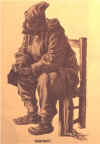 |
 |
Merchant Tokens -- examples of Lower Canada merchant
storecards: T.S. Brown (hardware), Francis Mullins (ships goods), and
Joseph Roy (dry goods). The
Joseph Roy is fairly scarce. |
|
Bouquet Sou -- probably the epitome of Canadian
tokens, this series is also the most widely collected.
There are about 30 major varieties that had been struck in various
mints in Belleville (New Jersey), Birmingham, Montreal, and elsewhere.
The legend “agriculture & commerce” was popular because it
is spelled the same for both French and English, thereby offending no one.
Eventually, about 1837, the tokens were so numerous (and light
weight) that they were eventually refused by the Banks.
These are primarily attributed according to the number of leaves on
the wreath and the position of the bow tying it. |
 |
 |
T.Duseaman Token (obverse) -- the dies for this token
supposedly originally read as T. D. Seaman as a storecard for Tobias
Seaman, but because the Belleville, New Jersey butcher (and hotelier)
rejected them it seems the diesinker
added a “U” between the “D” and the “S” thereby altering the
name. |
|
(reverse) -- the reverse shows the characteristic
heavy die crack. This token
was evidently struck on cheap copper planchets that were poorly prepared
as evidenced by many specimens having striations and other copper flaws. |
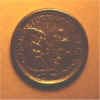 |
 |
Spread Eagle Tokens -- this is a series that began
with an 1813 original that was struck by a Boston merchant who settled in
Montreal, and were struck over the tokens of Bristol merchant Samuel
Guppy. The originals were not at first well received because of the use of
the eagle, an American symbol; remember that the War of 1812 had just
concluded. Light weight
imitations appeared about 1825 or later and were dated 1813, 1814, and
1815. |
|
Bust & Harp Token -- one of my two favorite
series, Courteau lists about 25 or so varieties.
The originals were struck in 1825 and later issues were antedated
to evade colonial regulations against the importation of tokens.
The imitations range from very crude workmanship to a moderately
high quality on both brass and copper alloys.
The attribution scheme centers on the number of strings in the
harp. |
 |
 |
Tiffin Tokens -- the other of my favorite series.
Available are both the original issue struck by Halliday for Joseph
Tiffin, a Montreal merchant in 1832, and the many imitations in both brass
and copper. In total Courteau
lists about 25 or so varieties. Again,
notice the antedating to 1812 in order to evade anti-importation
regulations. |
|
Blacksmith Tokens -- a funny series, the story
relayed by McLachlan is that many of these were struck by a Montreal
blacksmith who, whenever he felt the need for imbibing at the local
tavern, would make up whatever change would satisfy his appetite’s
needs. The designs and lettering on the dies were purposely left
only half finished so that the resulting token would appear to be well
worn with only a little of the original detail left.
These extremely crude tokens were sometimes struck with the image
and wording backwards as the diesinkers were evidently so dimwitted as not
to realize that the die needed to be made in reverse. |
 |
 |
Anticosti Island Token (obverse) -- a helmeted roman
bust appears on this token which is of doubtful Canadian pedigree.
Recent research in the past 30 years or so indicates that this
specimen was most likely struck by New York minter Lovett from pattern
dies produced in Paris around 1870 for trial strikings for coinage for the
Honduras. Because of the
attribution to Anticosti Island by Scott Stamp and Coin Company in an 1890
listing (perhaps because of the “A”), this token is often found in
Canadian colonial collections and listings. |
|
(reverse) -- shows the Paris “A” mintmark that
perhaps was once thought to indicate Anticosti. |
 |
 |
Civil War Token -- I included this in my collection
only because the diesinker used the Nova Scotia thistle as a device. |
|
Devins & Bolton -- Montreal merchants in the
later 19th century who, for a time, had much of the small change passing
through their establishment counterstamped with their store name. One of the most common counterstamps, it’s found on
Canadian tokens, U.S. large cents, and many other copper pieces.
The piece on the right only weighs 4.31 grams -- one of the
lightest copper pieces in my collection. |
 |
 |
W&J Bell 7-1/2 Pence -- the only paper money in
my collection, this particular specimen (circa 1837) was from merchants in
Upper Canada, but was never issued |
|
Photo of Joseph LeRoux -- one of the major
cataloguers of the late 19th century, this French-Canadian also issued his
own token as a storecard to invite subscriptions to his publications on
Canadian tokens. His parents
had their own prolific issuance: 29 children. |
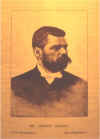 |
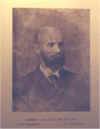 |
Photo of Robert McLachlan -- a well-published
Canadian numismatist, he was also one of the early presidents of the ANA
-- an organization once heavily represented by Canadians due to having no
national organizations of their own at the time. |
|
Photo of Napoleon Breton -- the best known cataloguer
of Canadian tokens, even today his numbering system developed late in the
19th century is the most widely used.
He, like LeRoux, was a professional who made his living in the
trade of coins and tokens. |
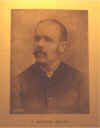 |
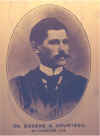 |
Photo of Eugene Courteau -- my favorite early
numismatist because of his careful and complete descriptions of the
extensive varieties of many of the series. |
|
Photo of Listing: includes the Charlton attribution
number, a unique serial number, Breton’s attribution number,
description, alloy, weight in grams, size in millimeters, year minted,
mint, denomination, grade, acquisition date, cost, and value.
I use it to keep track of what I have which is currently close to
400 Canadian colonials. |
 |
 |
Photo of Canadian Coin News: Canada’s counterpart
to Coin World, I use this to keep up with the latest news and to make
contact with various dealer and collectors who advertise in the classified
section. |
|
Photo of References: the three best books for these
series are the Charlton Standard Catalogue of Canadian Colonial Tokens
(2nd edition), Breton’s Popular Illustrated Guide to Canadian Coins,
Medals, etc. etc. (1894 and 1912 editions -- reprint is cheap), and
Quarterman Publishings anthology Canadian Tokens and Medals -- a
compilation of articles from The Numismatist. |
 |
 |
Photo of Other Resources: The CNJ from the CNA and
all of Courteau’s monographs as well as others by McLachlan, Howland
Wood, Lees, and others. |
Question and Answer
Period
That
was all that there was, folks. Hope you found something useful or
interesting...GB
|